THE PCL & PCI PLATFORM TECHNOLOGY
Our photochemical-based technology platform consists of two elements: a proprietary small molecule photosensitiser and a light source. The platform is under development in two different areas:
1) photochemical lysis (PCL), inducing selective light-triggered cell lysis, which may enhance yield and purity in viral vector manufacturing, and
2) photochemical internalisation (PCI), inducing light-triggered intracellular drug delivery, which may unlock the potential of a wide array of therapeutic modalities.
1) Photochemical lysis (PCL) – Enhancing manufacturing of viral vectors
Bioprocessing is the manufacturing of biological drugs, which involves complex processes that are bottlenecks in the endeavour to offer breakthrough therapies to new and larger patient populations. There is a great need for novel technologies that enable more effective bioprocessing with higher yield as well as increased quality.
Gene therapy utilises viruses (viral vectors) to deliver potentially lifesaving genetic medicines to patients. In the manufacturing process, viral vectors are produced by so-called “producer cells” (living cells) that act as “gene therapy factories”. The combination of living cells as factories and a complex output (viral vectors) is what makes the manufacturing so challenging.
Manufacturing of viral vectors includes intricate upstream and downstream processes. In the upstream process, cell lysis is the final step, where the produced viral vectors are extracted from the producer (host) cells. In the subsequent downstream process, the viral vectors are separated from various cell debris (host-cell impurities) in sequential purification steps.
PCI Biotech’s objective is to develop a novel photochemical technology (PCL) for increasing yield and reducing host-cell impurities in viral vector manufacturing, in particular manufacturing of adeno-associated viral vectors (AAV). PCL shall be applied in the upstream process to extract viral vectors from producer cells while reducing host-cell impurities.
The PCL mode of action
The PCL lysis effect is achieved by use of a photosensitising compound that is designed to anchor in the plasma membrane of the viral vector producer cells. Following illumination, the photosensitiser is activated, which selectively disrupts the producer cell plasma membrane. This allows release of entrapped viral vectors, such as AAV, with reduced host-cell impurities compared with industry standard lysis.
The PCL technlogy vs industry standard
2) Photochemical internalisation (PCI) – Intracellular drug delivery
PCI is uniquely positioned to significantly impact two pillars of drug development: immuno-oncology and nucleic acid-based therapies. Many of the active compounds employed in such therapies are encapsulated in so-called endocytic vesicles (endosomes) as they enter the target cell. Active compounds trapped in the endosomes are generally unable to exert their therapeutic effect since their therapeutic targets are located in other cellular compartments. PCI is able to unlock the intracellular capsules (endosomes) where the active compounds are entrapped, leading to increased access to their therapeutic targets.
The PCI effect is achieved by the use of a photosensitising compound that attaches to the cellular membrane of the target cells. During uptake of therapeutic drug molecules by endocytosis, the photosensitiser becomes incorporated in the membrane of the endocytic vesicles and co-localised with the drug. Following illumination that activates the photosensitiser, the integrity of the endosomal membrane is disturbed and the drug is released into the cytosol where it can reach its target of action. Since the effect occurs only where light is applied, PCI is a localised precision therapy.
Modifying intracellular trafficking for intratumoural immunotherapy
PCI is a technology designed for local enhancement of therapeutic effects and is well-suited for delivery of immune stimulants to tumour sites. As such, PCI can enhance the intracellular delivery of molecules relevant to locally administered immunotherapy.
PCI modifies the intracellular trafficking by re-localising endocytosed antigens and nucleic acid encoding immunological agents from endosomes to the cytosol in antigen presenting cells. This re-localisation may both promote presentation through the important MHC Class I pathway and stimulate general immunotherapeutic responses.
Site-directed intracellular nucleic acid delivery for use in dermatology
Nucleic acid therapeutics can potentially improve the treatment of dermatological diseases, but delivery to skin lesions remains an obstacle. One important reason for this is that nucleic acids in most cells are taken up by endocytosis, but are then trapped in endosomes, constituting a barrier severely limiting the therapeutic effect. This is a challenge the PCI technology is uniquely positioned to solve, by achieving site-directed intracellular nucleic acid delivery.
Animation of the PCI technology


